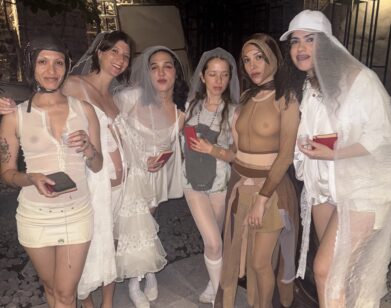The Legacy of Antonio Lopez
Until his untimely death in 1987, fashion illustrator and artist Antonio Lopez was commissioned by publications including The New York Times and Women’s Wear Daily, worked closely with designers such as Karl Lagerfeld, and discovered some of the 20th century’s most iconic models. He lived with Jerry Hall in Paris, after discovering her in New York, where he was also surrounded by Grace Jones, Pat Cleveland, and Jessica Lange (collectively known as “Antonio’s Girls”). Lopez and his creative partner Juan Ramos immersed themselves within New York’s downtown scene of the 1960s and ’70s, and could frequently be found at Max’s Kansas City in the company of Interview founder Andy Warhol. While Lopez and Warhol were not friends, per se, they were collaborators; for a number of years, Lopez served as Interview‘s in-house designer, and in February 1975 they produced a special Puerto Rico issue, paying homage to Lopez’s birth country. Now, visitors to El Museo del Barrio in New York can pick up a reprinted copy of the original issue, while viewing a comprehensive retrospective of his work, “Antonio Lopez: Future Funk Fashion.”
The exhibition brings together more than 400 works from various points in Lopez’s career, focusing upon four thematic traces: the body, the street, Afrofuturism, and music. “These themes became apparent in the work,” El Museo Curator Rocío Aranda-Alvarado says. “We could’ve had another big theme, fashion, but it didn’t fit with the story we wanted to tell, which is how much social interest is in the work, how many social issues he cares about.”
Aranda-Alvarado co-curated the show with Amelia Malagamba-Ansótegui, a visiting scholar. Featuring pieces from Lopez and Ramos’ archive, as well as a few items borrowed from private collections, they present everything from pencil sketches to videos and Instamatic photographs. It becomes evident that Lopez and Ramos focused on male and female bodies alike, often allowing Lopez’s heritage to seep through in subtle details, such as hand placements and body language.
“People have asked me, ‘How come he didn’t talk about being a Puerto Rican, a Nuyorican?’ But he didn’t need to,” Malagamba-Ansótegui says. “When I saw his work, I could read the cultural cues—the gestures of the break-dancers, integrating people of color in the motorcycle pictures. He intervened, interrupted, and disrupted.”
In addition to Lopez and Ramos’ work, the exhibition presents images and garments inspired by Lopez, but made by Bill Cunningham, Andy Warhol, and Karl Lagerfeld. So although “Future Funk Fashion” evokes serious discourse on gender, sexuality, race, and heritage, it is simultaneously celebratory, inviting viewers to revel in Lopez and Ramos’ brilliant legacy.
“ANTONIO LOPEZ: FUTURE FUNK FASHION” WILL BE ON VIEW AT EL MUSEO DEL BARRIO UNTIL NOVEMBER 26, 2016.







